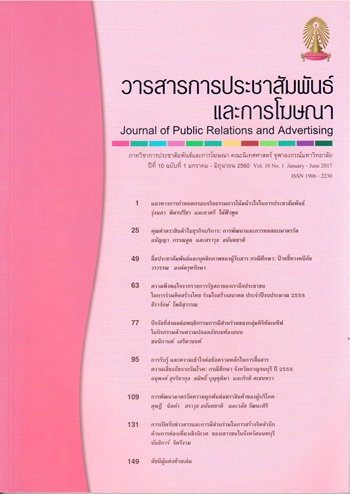แนวทางการกำหนดกรอบจริยธรรมการโน้มน้าวใจในการประชาสัมพันธ์
Main Article Content
Abstract
The objective of this research was draft a manual on ethical persuasion in public relations to provide Public Relations practitioners further direction in addition to what is included in professional ethical guidelines for PR practitioners. As a supplement, it can contribute to improving the effectiveness of public relations within the parameters of ethical practices. The methodology for collecting data and developing the ethical persuasion handbook comprises four steps: 1) data collection through interviews with 20 participants who represent affected publics, including PR practitioners, marketing communication practitioners and organization communication practitioners as well as Public Relations academia and private entrepreneurs, members of the media and social action groups/organizations to learn the type of PR persuasive tools which cause ethical problems, or controversies, in the Public Relations to develop a questionnaire to assess the ethical values of persuasive activities employed in public relations; 2) distribution of questionnaire to a sampling of 1,600 respondents, including PR practitioners, marketing communication practitioners and organization communications practitioners working in the public and private sectors, Public Relations academia and entrepreneurs who employ public relations, marketing communications and/or organizational communications, as well as members of the general public; 3) public participation of 101 persons during which time they are able to voice their thoughts and opinions. The participants included PR practitioners and students to acquire a comprehensive picture with clear and complete data that is easy to understand and can used in drafting the ethical persuasive PR practices manual; and 4) experts who can review the work and provide opinions on ethical persuasive PR practices to make improvements.
The results of the interviews of persons affected negatively by public relations can be summarized by saying that 23 key points were first identified for causing a negative effect while 19 outstanding problems in ethical persuasiveness in Public Relations were ascertained. When concepts discussed in the literature were combined with these and analyzed, the findings showed that the manual drafting on ethical persuasion in public relations identified 6 principles with a total of 30 guidelines. The results of analysis of the questionnaire found that each group saw the 6 principles important along with the 30 guidelines for action. The public relations practitioners and entrepreneurs who employ public relations felt all the guidelines were very important. The PR practitioners saw 18 guidelines very important, 12 somewhat important with 8 having different averages more or less than three. Statistical significance of these findings was 0.05 while 4 guidelines had an average difference among two sample groups, entrepreneurs and the general public, with a statistical significance of 0.05. This demonstrates that those who receive messages, or consumers, feel they need protection when receiving persuasive messages while entrepreneurs, themselves, want to use persuasive tactics that do not cause an adverse effect for their organization.
The Public Relations academia, who have an understanding about ethical persuasion in public relations, want to see the persuasive process employ ethics right from the start to provide the receiver, or consumer, with protection.
The results from listening to the opinions of the public about the preparation of the draft on ethical persuasive public relations also recognized the 6 principles and 30 channels for action. They felt the majority covered all concerns and were clear, easy to understand and could be implemented. The manual draft on ethical persuasiveness in Public Relations can then help practitioners as many cases seem to regularly arise.


